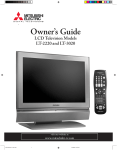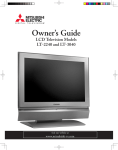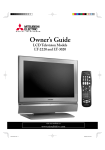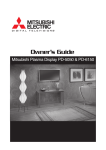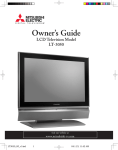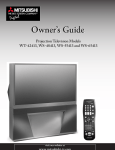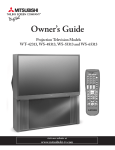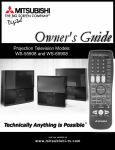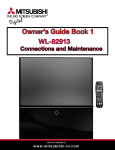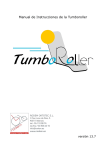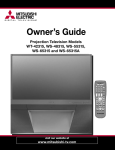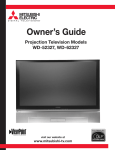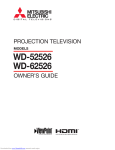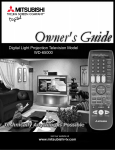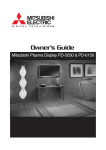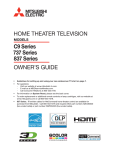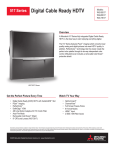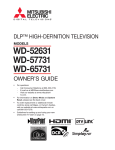Download Mitsubishi Electronics LT-4260 User's Manual
Transcript
Owner’s Guide LCD Television System LT-4260 (LCD Display model: L423FR) visit our website at www.mitsubishi-tv.com CAUTION RISK OF ELECTRIC SHOCK DO NOT OPEN CAUTION: TO REDUCE THE RISK OF ELECTRIC SHOCK, DO NOT REMOVE COVER OR BACK. NO USER SERVICEABLE PARTS INSIDE. REFER SERVICING TO QUALIFIED SERVICE PERSONNEL. The lightning flash with arrowhead symbol within an equilateral triangle is intended to alert the user of the presence of uninsulated “dangerous voltage” within the product’s enclosure that may be sufficient magnitude to constitute a risk of electric shock. The exclamation point within an equilateral triangle is intended to alert the user to the presence of important operating and maintenance (servicing) instructions in the literature accompanying the product. Note: This equipment has been tested and found to comply with the limits for a Class B digital device, pursuant to part 15 of the FCC Rules. These limits are designed to provide reasonable protection against harmful interference in a residential installation. This equipment generates, uses and can radiate radio frequency energy and, if not installed and used in accordance with the instructions, may cause harmful interference to radio communications. However, there is no guarantee that interference will not occur in a particular installation. If this equipment does cause harmful interference to radio or television reception, which can be determined by turning the equipment off and on, the user is encouraged to try to correct the interference by one or more of the following measures: • Reorient or relocate the receiving antenna. • Increase the separation between the equipment and the receiver. • Connect the equipment into an outlet on a circuit different from that to which the receiver is connected. • Consult the dealer or an experienced radio/TV technician for help. Product Name: Liquid Crystal High Definition TV system CAUTION: To assure continued FCC compliance, the user must use a shielded video interface cable with bonded ferrite cores at both ends, when using the MonitorLink™/HDMI™ input. Changes or modifications not expressly approved by Mitsubishi could void the user’s authority to operate this equipment. WARNING: TO REDUCE THE RISK OF FIRE OR ELECTRIC SHOCK, DO NOT EXPOSE THIS PRODUCT TO RAIN OR MOISTURE. CAUTION: TO PREVENT ELECTRIC SHOCK, MATCH WIDE BLADE OF PLUG TO WIDE SLOT, FULLY INSERT. NOTE TO CATV SYSTEM INSTALLER: THIS REMINDER IS PROVIDED TO CALL THE CATV SYSTEM INSTALLER’S ATTENTION TO ARTICLE 820-40 OF THE NEC THAT PROVIDES GUIDELINES FOR THE PROPER GROUNDING AND, IN PARTICULAR, SPECIFIES THAT THE CABLE GROUND SHALL BE CONNECTED TO THE GROUNDING SYSTEM OF THE BUILDING, AS CLOSE TO THE POINT OF CABLE ENTRY AS PRACTICAL. Hg LAMP(S) INSIDE THIS PRODUCT CONTAIN MERCURY AND MUST BE RECYCLED OR DISPOSED OF ACCORDING TO LOCAL, STATE OR FEDERAL LAWS. Contents Important Safeguards .................................................................................................................. 4 Cleaning Your LCD Television System ........................................................................................ 7 Chapter 1 Television System Overview Chapter 2 Television System Setup Chapter 3 Connections Chapter 4 Remote Control Functions Chapter 5 Menu Screen Operations Chapter 6 Special Features Thank You ................................................................................................................................... 9 Unpacking Your New TV System ................................................................................................ 10 Special Features ........................................................................................................................... 11 Side Control Panel and Card Reader ............................................................................................ 12 Side Panel Input/Output .............................................................................................................. 13 Attaching HD-6000 to 42" LCD Display ................................................................................... 15 Set-Back Configuration Setup ..................................................................................................... 16 Connecting a Computer ...................................................................................................... 20 Stand Alone Configuration Setup ................................................................................................ 21 Connecting a Computer ...................................................................................................... 22 Wall Mount Configuration Setup ................................................................................................ 23 Connecting a Computer ...................................................................................................... 27 Connecting a VCR to the LCD Side Panel .................................................................................. 29 Connecting an Audio Receiver .................................................................................................... 30 Connecting a DVD Player or Other S-Video Device ................................................................... 31 Connecting a Satellite Receiver/Cable Box................................................................................... 32 Connecting a Computer .............................................................................................................. 33 How Connections Affect the PIP and POP ................................................................................. 34 Overview of the TV Layer Buttons .............................................................................................. 37 Operation .................................................................................................................................... 38 Sleep Timer ................................................................................................................................. 39 Use With Other A/V Products .................................................................................................... 40 Operation of PIP, POP & Double Window ................................................................................. 42 The ViewPoint® Menu System .................................................................................................... 45 MAIN Menu ............................................................................................................................. 47 SETUP Menu .............................................................................................................................. 48 ADVANCED FEATURES Menu ............................................................................................... 50 AUDIO/VIDEO SETTINGS Menu ........................................................................................... 52 Available On-Screen Format Sizes.........................................................................................................57 Operation of PIP and POP and Double Window ........................................................................ 60 Appendix A: HD Input Connection Compatibility ..................................................................... 61 Appendix B: Supported PC Resolutions....................................................................................... 61 Appendix C: Remote Control Programming Codes..................................................................... 62 Appendix D: Media Command™ and Media Card Playback ..................................................... 64 Cable Management ...................................................................................................................... 66 Index............................................................................................................................................ 67 Troubleshooting ........................................................................................................................... 69 Warranty...................................................................................................................................... 74 IMPORTANT SAFEGUARDS Please read the following safeguards carefully before using this product and retain for future reference. Always follow all warnings and instructions marked on the product. 1. Read, Retain and Follow All Instructions 2. Heed Warnings 3. Read all safety and operating instructions before operating the product. Retain the safety and operating instructions for future reference. Follow all operating and use instructions. Adhere to all warnings on the product and in the operating instructions. Cleaning Unplug the product from the wall outlet before cleaning. Do not use liquid, abrasive, or aerosol cleaners. Cleaners can permanently damage the cabinet and screen. Use a lightly dampened cloth for cleaning. 4. Attachments and Equipment 5. Water and Moisture 6. Accessories Never add any attachments and/or equipment without approval of the manufacturer as such additions may result in the risk of fire, electric shock or other personal injury. Do not use the product where contact with or immersion in water is possible. Do not use near bath tubs, wash bowls, kitchen sinks, laundry tubs, swimming pools, etc. Do not place the product on an unstable cart, stand, tripod, or table. The product may fall, causing serious injury to a child or adult and serious damage to the product. Use only with a cart, stand, tripod, bracket, or table recommended by the manufacturer, or sold with the product. Any mounting of the product should follow the manufacturer’s instructions, and should use UL 1678 listed wall mounting brackets suitable for the weight and mounting surface used. The product and cart combination should be moved with care. Quick stops, excessive force, and uneven surfaces may cause the product and cart combination to overturn. 7. Ventilation 8. Power Source 9. Slots and openings in the cabinet are provided for ventilation and to ensure reliable operation of the product and to protect it from overheating. Do not block these openings or allow them to be obstructed by placing the product on a bed, sofa, rug, or other similar surface. Nor should it be placed over a radiator or heat register. If the product is to be placed in a rack or bookcase, ensure that there is adequate ventilation and that the manufacturer’s instructions have been adhered to. This product should be operated only from the type of power source indicated on the marking label. If you are not sure of the type of power supplied to your home, consult your appliance dealer or local power company. The socketoutlet shall be installed near the equipment and shall be easily accessible. Grounding or Polarization This product is equipped with a three-wire grounding-type plug, a plug having a third grounding pin. This plug will only fit into a grounding-type power outlet. This is a safety feature. If you are unable to insert the plug fully into the outlet, contact your electrician to replace your obsolete outlet. Do not defeat the safety purpose of the grounding-type plug. 10. Power-Cord Protection Power-supply cords should be routed so that they are not likely to be walked on or pinched by items placed upon or against them, paying particular attention to cords at plugs, convenience receptacles, and the point where they exit from the product. 11. Lightning For added protection for this product during a lightning storm, or when it is left unattended and unused for long periods of time, unplug it from the wall outlet and disconnect the antenna or cable system. This will prevent damage to the product due to lightning and power-line surges. 4 IMPORTANT SAFEGUARDS, continued 12. Power Lines An outside antenna system should not be located in the vicinity of overhead power lines or other electric, light or power circuits, or where it can fall into such power lines or circuits. When installing an outside antenna system, extreme care should be taken to keep from touching such power lines or circuits as contact with them might be fatal. 13. Overloading Do not overload wall outlets, extension cords or integral convenience receptacles as this can result in a risk of fire or electric shock. 14. Object and Liquid Entry Never push objects of any kind into this product through openings as they may touch dangerous voltage points or short-out parts that could result in fire or electric shock. Never spill liquid of any kind on or into the product. 15. Outdoor Antenna Grounding If an outside antenna or cable system is connected to the product, be sure the antenna or cable system is grounded so as to provide some protection against voltage surges and built-up static charges. Section 810 of the National Electric Code, ANSI/NFPA No. 70, provides information with respect to proper grounding of the mast and supporting structure, grounding of the lead in wire to an antenna discharge unit, size of grounding conductors, location of antenna discharge unit, connection to grounding electrodes, and requirements for the grounding electrode. 16. Servicing Do not attempt to service this product yourself as opening or removing covers may expose you to dangerous voltage or other hazards. Refer all servicing to qualified service personnel. EXAMPLE OF ANTENNA GROUNDING ANTENNA LEAD IN WIRE GROUND CLAMP ELECTRIC SERVICE EQUIPMENT ANTENNA DISCHARGE UNIT (NEC SECTION 810-20) GROUNDING CONDUCTORS (NEC SECTION 810-21) GROUND CLAMPS NEC — NATIONAL ELECTRICAL CODE POWER SERVICE GROUNDING ELECTRODE SYSTEM (NEC ART 250, PART H) 17. Damage Requiring Service Unplug the product from the wall outlet and refer servicing to qualified service personnel under the following conditions: (a) When the power-supply cord or plug is damaged. (b) If liquid has been spilled, or objects have fallen into the product. (c) If the product has been exposed to rain or water. (d) If the product does not operate normally by following the operating instructions, adjust only those controls that are covered by the operating instructions as an improper adjustment of other controls may result in damage and will often require extensive work by a qualified technician to restore the product to its normal operation. (e) If the product has been dropped or the cabinet has been damaged. The liquid crystal display used in this product is made of glass. It can break if dropped. Do not come in contact with the liquid crystals or glass in case the LCD display breaks. (f) When the product exhibits a distinct change in performance - this indicates a need for service. 18. Replacement Parts When replacement parts are required, be sure the service technician has used replacement parts specified by the manufacturer or have the same characteristics as the original part. Unauthorized substitutions may result in fire, electric shock or other hazards. 19. Safety Check Upon completion of any service or repair to the product, ask the service technician to perform safety checks to determine that the product is in safe operating condition. 20. Heat The product should be situated away from heat sources such as radiators, heat registers, stoves, or other products (including amplifiers) that produce heat. Do not place this product in an enclosed place (bookcase or wall) without proper ventilation. Do not block the vents or openings on this product. 5 IMPORTANT SAFEGUARDS, continued 21. Transport/Handling (a) Be sure to use another person to lift or carry this product. It is recommended that the product be carried by two people holding it with both of their hands — one hand on each side of the product. (b) Use caution when transporting the product. Be sure that items such as belt buckles, watches, shirt buttons, and zippers do not scratch or rub the screen or cabinet. (c) Do not grip the cut-outs shown in Diagram 1. These cut-outs are not handles. Diagram 1. DO NOT USE AS HANDLES 22. LCD Monitor This monitor uses a technology composed of over 2.9 million thin film transistors. It is common to find a few colored (non-active) “dots” on the screen. Do not be alarmed. This is a result of the manufacturing process found in all panels. Your picture performance will not be affected. 23. Wall or Ceiling Mounting The product should be mounted to a wall or ceiling only as recommended by the manufacturer. When mounting the LCD display to a wall or ceiling, the stand and Set-Back Box (HD-6000) must be removed from the back of the LCD display. CAUTION This product needs to be attached to the included stand or other optional mounting hardware. Use the following optional accessories. Use with other optional accessories is capable of resulting in instability causing possible injury. Manufacturer’s name: Mitsubishi Digital Electronics America, Inc. Tilt Wall Mount: LMOUNT-42T To order LMOUNT-42Ts, please call our Parts Department at (800)553-7278. Please contact Mitsubishi Digital Electronics America, Inc for approved optional accessories. 6 CLEANING Cleaning General Cleaning Warnings : Normally, light dusting with a dry, non-scratching duster will keep your product clean. If cleaning beyond this is needed, please use the following guidelines: • DO NOT allow liquid to enter the product through the ventilation slots or any crevice. • DO NOT use any strong or abrasive cleaners as these can scratch the surfaces. First, turn off the product and unplug the power cord from the power outlet. • DO NOT use any commercial cleaners with ammonia, bleach, alcohol, benzine, or thinners as these can dull the surfaces. Top and Sides of the Display: • DO NOT spray liquids or cleaners directly on the product’s surfaces. • Gently wipe down your product with a soft, nonabrasive cloth such as cotton flannel or a clean cloth diaper, lightly moistened with water. Dry with a second dry, soft, non-abrasive cloth. • DO NOT scrub or rub the product harshly. Wipe it gently. • Excessive moisture or water may damage your product. Use caution when wiping your product. DO NOT use any kind of abrasive or liquid cleaner on the surface of the TV Display. For further information, please call Consumer Relations at: 800-332-2119 ENVIRONMENTAL CONDITIONS Operating Temperature: 5 - 35 deg C Humidity: 30 - 80% relative (without condensation) Storage Temperature: 20 - 50 deg C Humidity: 10 - 90% relative (without condensation) 7 Chapter . . . Television System Overview Thank You .................................................................................................................. 9 Unpacking Your New TV System ............................................................................. 10 Special Features ......................................................................................................... 11 Side Control Panel and Card Reader ......................................................................... 12 Side Panel Input/Output ........................................................................................... 13 1 Thank You for Your Purchase Welcome to the wonderful and exciting world of digital television! We are honored that you chose Mitsubishi as your premier home entertainment partner. The development team at Mitsubishi Digital Electronics America (MDEA) understands that our customers demand and expect the very best. MDEA was founded on the core beliefs and philosophies that drive us to deliver products that implement the latest in advanced television technology. While some televisions are destined for obsolescence in the near future, MDEA’s televisions are all HDupgradeable. This cornerstone of your home entertainment system will continue to provide unparalleled enjoyment for years to come! Whether this is your first Mitsubishi consumer electronics product or another addition to your growing Mitsubishi system, we hope that this television will bring you many hours of enjoyment. 9 Unpacking Your New TV System Please take a moment to review the following list of items to ensure that you have received everything below: MOA01-01 Please send other correspondence to: Enter the PRODUCT REGISTRATION Register your purchase and you’ll be automatically entered for a chance to win $5,000, $25,000 or even $50,000! $100,000 Give Away V OFFICIAL SWEEPSTAKES RULES: NO PURCHASE NECESSARY TO WIN. Sweepstakes is sponsored by a number of different companies, will be offered in a number of different presentations, and will award the following prizes: one 1st Prize of $50,000; one 2nd Prize of $25,000; and five 3rd Prizes of $5,000. Sweepstakes begins May 19, 2003, and ends December 31, 2005. Enter by completing this product registration or a 3" x 5" card with your name, address, city, state, ZIP Code, and the words “$100,000 Give Away V” and mail to P.O. Box 174268, Dept. MOA, Denver, CO 80217-4268. Entries must be received no later than December 31, 2005, and are limited to one per household. Mechanically reproduced entries not acceptable. Not responsible for late, lost or illegible entries. A random drawing held in January 2006, will select the winners from all entries collectively received by the sponsoring companies. Odds of winning depend on the number of eligible entries received from all sponsors’ presentations. Open to U.S. residents at least 18 years old, except employees and their families of the sweepstakes judge, all of the sponsoring companies, and their respective subsidiaries. Each winner must submit a signed and notarized affidavit of eligibility within a specified time after being notified of their prospective winner status, and if a satisfactory affidavit is not received within the stated time, a new winner will be selected. By submitting an entry, winner agrees to the use of their name, address, and photograph for advertising/publicity purposes without compensation. All entries become the property of the sweepstakes judge. No transfer or substitution of prize is allowed. Winner is solely responsible for all taxes. All federal, state and local laws apply. Offer void in Florida and where prohibited by law. For notice of sweepstakes winners, send a self-addressed, stamped envelope to: “$100,000 Give Away V”, P.O. Box 173133, Denver, CO 80217-3133. (1) AC Cord (1) RS-232C Cable (1) HDMI Cable (2) AA Batteries (1) Remote Control (1) Registration Card (1) HD-6000 Owner’s Guide (1) HD-6000 Digital Cable Ready HDTV Receiver/Controller (4) Tie Wraps (1) Cable Management cover (8) M4 Bolts (2) M3 Bolts (4) Mounting Hooks (1) AC Cord (1) USB Cable (1) Registration Card (1) Owner’s Guide for LT-4260 (1) LCD Display First-Class Postage Required Post Office will not deliver without proper postage. Mitsubishi Digital Electronics America, Inc. 9351 Jeronimo Rd. Irvine, CA 92618-1904 P O BOX 174268 DENVER CO 80217-4268 !802174268688! Included in the HD-6000 carton are the following items: POWER PRODUCT REGISTRATION 10 Special Features Your new LT-4260 High Definition Television System has many special features. This makes it the perfect control center for your home entertainment system. These special features include: Multiple Connection Capability On the HD-6000 back panel you will find a full complement of the connections needed for the most sophisticated home theater system. Included are standard Audio/Video/S-Video, wideband component video, FireWire®, IEEE 1394, CableCARD™ and both an HDMI™ Input and an HDMI™ Output. TV Disc Internal Digital Video Recorder (DVR) TV Disc is an internal 120GB high definition hard disk drive recorder (also called a digital video recorder or DVR). It is able to record digital and analog programs received from CableCARD™ channels, Antenna 1, Antenna 2, devices connected to Input 1, 2 or IEEE 1394 devices. This exciting feature may record as much as 12 hours of high definition TV programming and includes live TV pause with instant replay. Now you can record a high definition program and watch it later without any picture quality loss and without a VCR. Recordings on the TV Disc can be sent by IEEE 1394 to D-VHS VCRs or to other IEEE 1394 compatible TVs. When recording analog programs, TV Disc will even use Dolby Digital® Record to convert the analog stereo to high quality digital stereo compatible with Dolby Digital® decoding surround receivers. Digital Cable Ready (CableCARD™) Your widescreen Mitsubishi HDTV receiver/controller is "Plug-and-Play" ready. It can descramble a cable provider's one-way digital signals with the use of a CableCARD™ security module. The CableCARD™ is used in place of a traditional cable box to access digital cable programming (including high definition). Contact your local cable provider for availability information and service details. NetCommand® Home Network Control System Your Mitsubishi HDTV receiver/controller offers a new level of networking to combine selected older products with new and future digital products. NetCommand supports IEEE 1394 connections, Audio Video Control system (AV/C), 5C copy protection and IR control of selected older products such as VCRs, DVD players, cable boxes or satellite receivers. NetCommand includes the ability to learn remote control signals directly from many devices, allowing you to customize the NetCommand system in a way that works best for your viewing. LT-4260 The HD-6000 is designed to work with all of the features of the Mitsubishi LT-4260 LCD HDTV display. 11 Side Control Panel and Card Reader Many remote control buttons are duplicated on the side control panel. Please see Remote Control Functions, page 37, for an explanation of their usage. (left side of LCD Display) (right side of LCD Display) CARD 1 MMC & SD™ CARD 3 Compact Flash® CARD 2 SmartMedia™ CARD 4 Memory Stick® GUIDE See Media Card Playback, Page 64, For Details. The ADJUST, ENTER, MENU, and CANCEL buttons may be used to access or navigate through the screen menus 12 Side Panel Input/Output ����������������������� ������������ ����������������������� ������������ � � � � � � � ����� � 6. PC Audio Input This is used to send the sound from a computer to the LCD Displays speakers. � �� 1. Headphone The Headphone Output sends the LCD Displays connected audio signals to a pair of headphones. The audio output from the TV’s speakers will be unavailable. 2. Audio Out The Audio Output sends the LCD Displays connected audio signals to an A/V receiver or other equipment. 3. Composite Input These inputs can be used for the connection of a VCR, Super VHS (S-VHS) VCR, laser disc player, or other A/V device to the TV. With each input, you may connect to the S-VIDEO or VIDEO terminal but not to both. 4. Component Input This input can be used for the connection of A/V equipment with component video outputs, such as a DVD player or compatible Video Game System. Please see Appendix A, page 61, for signal compatibility. 7. HDMI™/MonitorLink™ Input This is a Mitsubishi-exclusive proprietary digital interface for the display of high quality digital video signals from Mitsubishi products such as the HD-6000 HDTV Receiver/Controller. All video signals, both analog and digital are sent digitally to your Mitsubushi TV. Can also be used as a HDMI™ input for other compatible sources. Note: The HDMI™-HDTV input terminal is compliant with the EIA-861 standard and is not intended for use with personal computers. 8. MonitorLink™ control/RS-232C for HD-6000 A digital control interface that works in parallel with MonitorLink™. While MonitorLink™ provides the digital video signal, MonitorLink™ Control provides enhanced functioning such as automatic power ON/OFF and input selection. Can also be used with other compatible RS-232C external devices. Please visit www.mitsubishi-tv.com for more information or RS-232C command structure. 9. Authorized Card Reader This USB input connects only to the HD-6000 and enables the use of the media card reader located on the LCD Display side panel. See Page 64 for details. CAUTION 5. PC Input This input can be used for analog RGB signals from a personal computer. Supported resolutions include VGA, SVGA, XGA, and WXGA only. Please see Appendix B, page 61 for supported PC Resolutions. 13 DO NOT CONNECT ANY USB DEVICE TO THIS INPUT. 10. DVI Audio Input Use this input to provide sound when an HDMI to DVI adapter is used. Chapter . . . Television System Setup Attaching HD-6000 to 42" LCD Display ................................................................. 15 Set-Back Configuration Setup ................................................................................... 16 Connecting a Computer ............................................................................................ 20 Stand Alone Configuration Setup ............................................................................. 21 Connecting a Computer ............................................................................................ 22 Wall Mount Configuration Setup ............................................................................. 23 Connecting a Computer ............................................................................................ 27 2 Television System Setup The LT-4260 LCD Television System is extremely versatile. The System includes a 42" LCD Display and a HD-6000 Digital Cable Ready HDTV Receiver/Controller. To take full advantage of all the features this system has to offer, attach the HD-6000 to the 42" LCD Display. Attaching HD-6000 to 42" LCD Display The HD-6000 can be connected to the 42" LCD Display by one of the following methods. Set-Back Configuration Stand Alone Configuration Wall Mount Configuration When the HD-6000 is connected to the 42" LCD, the HD-6000 front control buttons are inactive. To control the HD-6000 (and 42" LCD), set the remote control to the CABLE/DBS/DTV Layer or use control buttons located on the side of the LCD Display. 2 15 4 Set-Back Configuration Setup CAUTION • Do not remove the stand. • The Display is heavy. Move it with two or more people. 1. Place the 42" LCD Display on a sturdy surface. 2. Remove the HD-6000 Receiver/Controller from its carton. 3. Remove the protective material from around the HD-6000 and place it on a sturdy surface. 4. Turn the HD-6000 over so that the bottom is facing up and gently place it on the protective material. 5. Attach the 4 Mounting Hooks. ���������������� When the HD-6000 is connected to the 42" LCD, the HD-6000 front control buttons are inactive. To control the HD-6000 (and 42" LCD), set the remote control to the CABLE/DBS/DTV Layer or use control buttons located on the side of the LCD Display. 16 Set-Back Configuration Setup (continued) 6. Grasp the HD-6000 from the top and bottom. Slide the HD-6000 into place making sure that all 4 mounting hooks connect to the corresponding pin located on the LCD Display stand. PIN ON LCD Display HOOK ON HD6000 PIN ON LCD Display HOOK ON HD6000 HOOK ON HD6000 PIN ON LCD Display HOOK ON HD6000 PIN ON LCD Display 17 Set-Back Configuration Setup (continued) 7. Secure the HD-6000 to the stand using the two M3 Bolts. 18 Set-Back Configuration Setup (continued) 8. Connect the HDMI™ Cable from the HDMI™ Output connector on the back of the HD-6000 to the HDMI™/MonitorLink Input connector located on the back of the LCD Display. HD-6000 Back Panel (section detail) LCD Display Back Panel (section detail) 9. Connect the USB Cable from the Authorized Card Reader connector on the back of the HD-6000 to the AUTHORIZED CARD READER connector on the back of the LCD Display. HD-6000 Back Panel (section detail) LCD Display Back Panel (section detail) 10. Connect the RS-232C Cable from the MonitorLink™ Control RS-232C connector on the back of the HD-6000 to the RS-232C/MonitorLink™ Control for HD-6000 connector on the back of the LCD Display. HD-6000 Back Panel (section detail) 19 LCD Display Back Panel (section detail) Set-Back Configuration Setup (continued) 11. Connect the AC Power Cord from the back of the HD-6000 to the back of the LCD Display. HD-6000 Back Panel (section detail) LCD Display Back Panel (section detail) 12. Connecting a Computer (OPTIONAL) • Your Mitsubishi LCD display supports VGA, SVGA, XGA, and WXGA PC resolutions only. See Appendix B: Supported PC Resolutions, P. 61 When connecting a PC to the LCD Television System, connect the PC directly to the LCD display. Do not connect the PC to the HD-6000. a. Connect a Mini D-sub 15-pin (RGB) cable from the LCD Display back panel to PC or Macintosh® LCD Display Side Panel back panel. b. Connect a PC Audio Cable (or 1/8” stereo mini jack cable) from the LCD side panel to PC or Macintosh back panel. LCD Display Back Panel (section detail) to PC or Macintosh® back panel � � to PC or Macintosh® back panel Figure 7. Connecting Computer 13. Refer to Chapter 2 (in the HD-6000 Owner's Guide) on how to connect A/V equipment (DVD player, Cable Box, etc) to the back panel of the HD-6000. 14. Refer to HD-6000 Owner’s Guide for complete operating instructions. The HD-6000 controls all features that the LCD HDTV system has to offer. 20 Stand Alone Configuration Setup CAUTION • Do not remove the stand. • The Display is heavy. Move it with two or more people. 1. Place the 42" LCD Display on a sturdy surface. 2. Remove the HD-6000 Receiver/Controller from its carton. 3. Place the HD-6000 Receiver/Controller on a sturdy surface. When the HD-6000 is connected to the 42" LCD, the HD-6000 front control buttons are inactive. To control the HD-6000 (and 42" LCD), set the remote control to the CABLE/DBS/DTV Layer or use control buttons located on the side of the LCD Display. 4. Connect the HDMI™ Cable from the HDMI™ Output connector on the back of the HD-6000 to the HDMI™/MonitorLink™ INPUT connector located on the back of the LCD Display. HD-6000 Back Panel (section detail) LCD Display Back Panel (section detail) 5. Connect the USB Cable from the Authorized Card Reader connector on the back of the HD-6000 to the AUTHORIZED CARD READER connector on the back of the LCD Display. HD-6000 Back Panel (section detail) LCD Display Back Panel (section detail) 6. Connect the RS-232C Cable from the MonitorLink™ Control RS-232C connector on the back of the HD-6000 to the RS-232C/MonitorLink™ Control for HD-6000 connector on the back of the LCD Display. HD-6000 Back Panel (section detail) 21 LCD Display Back Panel (section detail) Stand Alone Configuration Setup (continued) 7. Connect the AC Power Cord from the back of the HD-6000 to the back of the LCD Display. HD-6000 Back Panel (section detail) LCD Display Back Panel (section detail) 8. Connecting a Computer (OPTIONAL) • Your Mitsubishi LCD display supports VGA, SVGA, XGA, and WXGA PC resolutions only. See Appendix B: Supported PC Resolutions, P. 61 When connecting a PC to the LCD Television System, connect the PC directly to the LCD display. Do not connect the PC to the HD-6000. a. Connect a Mini D-sub 15-pin (RGB) cable from the LCD Display back panel to PC or Macintosh® LCD Display Side Panel back panel. b. Connect a PC Audio Cable (or 1/8” stereo mini jack cable) from the LCD Display side panel to PC or Macintosh back panel. LCD Display Back Panel (section detail) to PC or Macintosh® back panel � � to PC or Macintosh® back panel Figure 7. Connecting Computer 9. Refer to Chapter 2 (in the HD-6000 Owner's Guide) on how to connect A/V equipment (DVD player, Cable Box, etc) to the back panel of the HD-6000. 10. Refer to HD-6000 Owner's Guide for complete operating instructions. The HD-6000 controls all features that the LCD HDTV system has to offer. 22 Wall Mount Configuration Setup CAUTION • Mitsubishi recommends that only qualified service personnel mount the LCD display. Customers should not attempt to do the work themselves. Mitsubishi bears no responsibility for improper mounting or mounting that results in an accident or injury. • Carefully read the installation instructions that come with the wall mount before starting installation. 1. Before performing work make sure to disconnect the AC Power cord from the 42" LCD Display. 2. Before performing work spread the protective sheet, which was wrapped around the display, on a flat, even surface. This will prevent the display from being damaged. 3. Gently lay the LCD Display face down on the protective sheet. 4. Do not touch or hold the screen face while carrying the display. 5. Remove the screws indicated by the arrows. Remove the stand cover. ���������������� 23 When the HD-6000 is connected to the 42" LCD, the HD-6000 front control buttons are inactive. To control the HD-6000 (and 42" LCD), set the remote control to the CABLE/DBS/DTV Layer or use control buttons located on the side of the LCD Display. Wall Mount Configuration Setup (continued) CAUTION Be sure to use another person to hold or support the stand while removing the screws. The stand can easily fall resulting in injury or damage. 6. Remove the Screws indicated by the arrows. ���������������� 24 Wall Mount Configuration Setup (continued) 7. Slide the stand in the direction indicated by the arrows and remove it. CAUTION When the Stand's Metal Hooks (Right and Left) are unlocked, the Stand can easily fall resulting in injury or damage. ����� ����������� ���������������� 8. The LCD Display is now ready to mount. 9. Connect the HDMI™ Cable from the HDMI™ Output connector on the back of the HD-6000 to the HDMI™/MonitorLink INPUT connector located on the back of the LCD Display. HD-6000 Back Panel (section detail) LCD Display Back Panel (section detail) 10. Connect the USB Cable from the Authorized Card Reader connector on the back of the HD-6000 to the AUTHORIZED CARD READER connector on the back of the LCD Display. HD-6000 Back Panel (section detail) 25 LCD Display Back Panel (section detail) Wall Mount Configuration Setup (continued) 11. Connect the RS-232C Cable from the MonitorLink Control RS-232C connector on the back of the HD-6000 to the RS-232C/MonitorLink Control for HD-6000 connector on the back of the LCD Display. HD-6000 Back Panel (section detail) LCD Display Back Panel (section detail) 12. Connect the AC Power Cord from the back of the HD-6000 to the back of the LCD Display. HD-6000 Back Panel (section detail) LCD Display Back Panel (section detail) 26 Wall Mount Configuration Setup (continued) 13. Connecting a Computer (OPTIONAL) • Your Mitsubishi LCD display supports VGA, SVGA, XGA, and WXGA PC resolutions only. See Appendix B: Supported PC Resolutions, P. 61 a. Connect a Mini D-sub 15-pin (RGB) cable from the LCD Display Back panel to PC or Macintosh® back panel. When connecting a PC to the LCD Television System, connect the PC directly to the LCD display. Do not connect the PC to the HD-6000. b. Connect a PC Audio Cable (or 1/8” stereo mini jack cable) from the LCD side panel to PC or Macintosh back panel. LCD Display Side Panel LCD Display Back Panel (section detail) to PC or Macintosh® back panel � � to PC or Macintosh® back panel Figure 7. Connecting Computer 14. Refer to Chapter 2 (in the HD-6000 Owner's Guide) on how to connect A/V equipment (DVD player, Cable Box, etc) to the back panel of the HD-6000. 15. Refer to HD-6000 Owner’s Guide for complete operating instructions. The HD-6000 controls all features that the LCD HDTV system has to offer. 27 Chapter . . . 3 Connections Connecting a VCR directly to LCD Side Panel ............................................................. 29 Connecting an Audio Receiver ...................................................................................... 30 Connecting a DVD Player or Other S-Video Device ..................................................... 31 Connecting a Satellite Receiver/Cable Box.................................................................... 32 Connecting MonitorLink™ or a Computer .................................................................. 33 How Connections Affect the PIP and POP .......................................................................34 Additional connection cables are not provided with the TV. They should be available at most electronic stores. The Display Side Panel is shut-off when the HD-6000 is connected to the LCD Display using a HDMI™ cable. Refer to Chapter 2 in the HD-6000 Owner’s Guide on how to connect A/V equipment to the HD-6000. The HD6000 does not shutoff the PC INPUT. Connecting a VCR directly to LCD Side Panel NOTE: The LCD Display side panel connections shown below can only be used when the HD-6000 is not connected to the LCD Display. Composite Video with Audio or SVideo with Audio (Recommended) ���������������������� (Figure 1) 1. 2. Connect a set of audio cables from AUDIO OUT on the VCR back panel to VIDEO INPUT/ AUDIO RIGHT & LEFT on the LCD Display side panel. ��� � ����� � ������������ ������������ �� ������� • The red cable connects to the R (right) channel • The white cable connects to the L (left) channel � ����� � ��� � � ����� � � � ��������� �������� ��������� � � ������ ���� ����������������������� ��� �������������������� ����� ���� ������������������� �������������� Connect a video or a S-Video cable from VIDEO OUT on the VCR back panel to VIDEO INPUT on the LCD Display side panel. ������� � ��� Figure 1. Connecting the VCR Audio/Video. 29 You may connect to the S-VIDEO or VIDEO terminal but not to both. Connecting an Audio Receiver Directly to LCD Side Panel NOTE: The LCD Display side panel connections shown below can only be used when the HD-6000 is not connected to the LCD Display. Stereo Audio System (recommended for shelf units or A/V receivers without digital audio inputs) (Figure 2) 1. ���������������������� ��� � Connect the audio cables from AUDIO OUT on the LCD Display side panel to TV IN or AUX IN terminals on the back of the audio system. ����� • The red cable connects to the R (right) channel • The white cable connects to the L (left) channel 2. Turn off the LCD Display speakers through the AUDIO/VIDEO SETTINGS Menu, page 52. ������������������������������� � 3. Set the audio system’s input to the TV or AUX position to hear the LCD Displays audio through a stereo system. Additional connection cables are not provided with the TV. They should be available at most electronic stores. ����� ��� �� �� ��� �� �� ������ ��� �� ������ ��� � � Figure 2. Connecting the Stereo Audio System. These types of audio connection do NOT support multi-channel digital audio. Please refer to your other devices Owner’s Guide to verify. A/V Receiver �������������������������������� � (Figure 3) 1. ��� Connect either a video cable or a S-Video cable (but not both) from VIDEO MONITOR OUT on the back of the A/V receiver to VIDEO INPUT on the LCD Display side panel. Connect a set of audio cables from AUDIO OUT on the LCD Display side panel to AUDIO TV IN on the back of the A/V receiver. • The red cable connects to the R (right) channel • The white cable connects to the L (left) channel ����� ���������������������� � 2. ��������� ��� ������ ��� � ����� ������ ������ ���� ��� ����� ���� � ������� Figure 3. Connecting the A/V Receiver. Note: Please see your A/V receiver Owner’s Guide for more detailed connections. 30 Connecting a DVD Player or Other S-Video Device Directly to LCD Side Panel NOTE: The LCD Display side panel connections shown below can only be used when the HD-6000 is not connected to the LCD Display. DVD Player/Video Game with Component Video � (Figure 4) ��� ����� � � � � 1. Connect the Component Video cables from (YCb Cr or Y Pb Pr) VIDEO OUT on the back of the DVD player to COMPONENT VIDEO INPUT on the LCD Display side panel. The correct connections are: A. Y to Y B. Cb or Pb to Pb C. Cr or Pr to Pr 2. Connect a set of audio cables from AUDIO OUT on the back of the DVD player to COMPONENT VIDEO Input/AUDIO RIGHT & AUDIO LEFT on the LCD Display side panel. ����������� ���������� �������������� � ��������� � � � � ����� ��������������� ��� ������������� ������ ����� ���������� ���������� ����� �� ������� ����� ����������������������������������� ��������������������������������� � ���������� � ������������ �� � ��������� �������� ��������� ����� �������������� ��� ������������������������������ ������������� ������� ������� ������������������ ���������������� ������������� � Figure 4. Connecting a DVD Player with Component Video. See Appendix A, page 61, for component video signal compatibility information. • The red cable connects to the R (right)channel • The white cable connects to the L (left) channel NOTE: Some video game systems support component connections. Please refer to your video game console Owner’s Guide. NOTE: If your DVD player supports progressive scan playback, be sure to set your player accordingly. Please refer to your DVD player’s Owner’s Guide. For digital audio connections, see your DVD and A/V receiver Owner’s Guides. ���������������������� Other S-Video Device (Figure 5) � 1. ��� ����� � Connect a set of audio cables from AUDIO OUT on the device back panel to VIDEO INPUT/ AUDIO RIGHT & AUDIO LEFT on the LCD Display side panel. • The red cable connects to the R (right) channel • The white cable connects to the L (left) channel 2. ������������������ �������� ��������� ����� � � ��� � ��������� ����� � � � � Figure 5. Connecting an S-Video Device. 31 � Connect a S-Video cable from VIDEO OUT on the device back panel to VIDEO INPUT on the LCD Display side panel. Connecting a Satellite Receiver/Cable Box Directly to LCD Side Panel NOTE: The LCD Display side panel connections shown below can only be used when the HD-6000 is not connected to the LCD Display. See Appendix A, page 61 for component video signal compatibility information. For digital audio connections, see your DTV receiver and A/V receiver Owner’s Guides. Satellite Receiver/Cable Box with Component Video Connections ���������������������� (Recommended) (Figure 6) 1. Connect RCA-type cables from the Satellite receiver/Cable Box outputs to the LCD Display side panel. Component VIDEO INPUT may be used for 480i, 480p, 720p or 1080i components. ��� � � ����� � � � 2. Connect the L (left) and R (right) audio cables from the Satellite/Cable Box receiver to COMPONENT VIDEO INPUT/AUDIO RIGHT & AUDIO LEFT on the LCD Display side panel. 3. To utilize the benefits of a digital A/V receiver, connect your Satellite/Cable Box receiver’s digital audio out to a digital input on your digital A/V receiver. See your Satellite/Cable Box receiver and A/V receiver Owner's Guides for instructions. ����������������������������������������������������� ������� � � � � �� � � � ��� ������� � �� ���������� � ������ ������������������������ ����������� ����� ����� ����� � ��������� ���� ���� ��� ������� ��������� �� ������ ������ ������� ����������� ������������ Figure 6. Connecting a Satellite receiver with component Video Connections. 32 Connecting a Computer Directly to LCD Display LCD Display Side Panel When connecting a PC to the LCD Television System, connect the PC directly to the LCD display. Do not connect the PC to the HD-6000. LCD Display Back Panel (section detail) to PC or Macintosh® back panel � � to PC or Macintosh® back panel Figure 7. Connecting Computer Connecting a Computer (Figure 7) • Your Mitsubishi LCD display supports VGA, SVGA, XGA, and WXGA PC resolutions only. See Appendix B: Supported PC Resolutions, P. 61 a. Connect a Mini D-sub 15-pin (RGB) cable from the LCD Display Back panel to PC or Macintosh® back panel. b. Connect a PC Audio Cable (or 1/8” stereo mini jack cable) from the LCD Display side panel to PC or Macintosh back panel. The Mini D-sub 15-pin (RGB) and 1/8” (3.5mm) stereo mini jack cables can be found at your local electronics store. Connecting your computer to this LCD will allow you to display your computer’s images. Since this monitor is widescreen (16:9 aspect ratio), the display configuration will vary depending on which video card or driver(s) you use. You may also need to use a Macintosh® adapter when connecting to some Macintosh® computers. 33 How Connections Affect the PIP (Picture-In-Picture) and POP (Picture-Outside-Picture) and DW (Double Window) This information only applies when the HD-6000 is not connected to the LCD Display. To see a picture in the PIP, POP or Double Window you may need to select an input source. If other video equipment is connected, you may be able to view these input sources as the PIP/POP. When connecting your LCD Display, it is important to understand which main picture and PIP/POP input sources can and cannot be used together. The table on this page shows which inputs can and cannot be used together and the limitations they may have. If you press the INFO button it will display the current Input signal (480i, 480p, 720p, or 1080i), format, and sleep time. See Operation of PIP and POP, page 60, for operating instructions. PIP/POP (sub) Main Input Input Component HDMI 480i, 480p, 720p, 1080i PC OK OK OK OK Component 480i, 480p, 720p, 1080i HDMI OK OK OK OK OK OK OK OK PC OK OK OK OK 34 This page intentionally left blank 35 Chapter . . . 4 Remote Control Functions Overview of the TV Layer Buttons ............................................................................... 37 Operation ...................................................................................................................... 38 Sleep Timer .................................................................................................................. 39 Use With Other A/V Products ...................................................................................... 40 Operation of PIP, POP and Double Window ............................................................... 42 Remote Control Functions: Overview of the TV Layer Buttons Overview (Figure 8, following page) 18-FORMAT: Change the shape and size of the main TV picture. 1-Slide Switch: Select A/V product to be controlled by the remote control. 19-REC: Manually record with a VCR or recordable DVD. 2-POWER: Turns power on and off for LCD Display and other connected A/V products. 20-REW/REV: Rewind or reverse search with a VCR, reverse scan with a DVD, or skip reverse with a CD. 3-DEVICE: Select the input to view; Component, Input, PC, or HDMI™. 21-PLAY: Play a VCR, DVD, or CD. 4-VOLUME: Change sound level. 22-STOP: Stop a VCR, DVD, or CD. 5-MUTE: Turn sound on or off. 23-FF/FWD: Fast forward or forward search with a VCR, fast play with a DVD, or skip forward with a CD. 6-TV MENU: Display system. on-screen menu 7-ADJUST: Navigate menus, change settings, and move the PIP on-screen location. 8-ENTER: Select a channel number or menu item. 9-HOME: Exit on-screen menus and return to TV viewing. 10-INFO: Display on-screen summary of the current input used and any broadcast information available (including current Signal Source and Format). Additionally, if you press the INFO key, it will display sleep time. 11-AUDIO: Select the individual audio settings. 12-VIDEO: Select the individual video settings. 13-PIP CH: Scroll up or down through memorized channels in PIP or POP. 14-PIP/POP: Cycle through PIP and POP display choices. 15-EXCH: Exchange PIP or POP with the main TV picture. 16-SLEEP: Set the LCD Display to turn off within 2 hours. See Sleep Timer, page 39, for setup instructions. 17-PIP DEVICE: Select the PIP or POP input source. 37 24-PAUSE: Pause a VCR, DVD, AV Disc, or freeze the PIP or POP image. Remote Control Functions: Operation Operation 1 Installing the Batteries: (Figure 9) 2 1. Remove the remote control’s back cover by gently pressing the ridged tab in the direction of the arrow and sliding off the cover. 2. Load the batteries, making sure the polarities (+) and (-) are correct. For ease of installation, install the negative (-) side first. 4 3 5 6 8 7 9 For Best Results from the Remote Control: Be within 20 feet of the equipment. Do not press two or more buttons at the same time unless instructed to. Do not allow to get wet or become heated. 10 14 12 11 16 13 17 19 18 21 20 15 24 23 22 Avoid dropping on hard surfaces. Do not use harsh chemicals to clean. Use only a soft, lightly moistened cloth. Do not mix new and old batteries. Figure 8. Remote Control Functions. Do not heat, take apart, or throw batteries into fire. Use only AA batteries. Operating the Remote Control: You can use the remote to control the LCD Display and other A/V (CABLE/DBS/DTV, VCR, DVD, and AUDIO) products. Select the product you want to control by moving the slide switch to the appropriate position. The remote control has been preset to operate the LCD Display and other Mitsubishi products. To program the remote control to operate other products, see Use of the Remote Control with Other A/V Products, page 40. Figure 9. Installing the batteries. The remote control may return to its initial setting when the batteries are changed. You may need to reprogram. 38 TV MENU HOME Remote Control Functions: Sleep Timer DEVICE MENU CANCEL Sleep Timer V-CHIP AUDIO INFO VIDEO (Figures 10 & 11) Setting the Sleep Timer: PIP/POP PIP CH PIP DEVICE EXCH FORMAT SLEEP 1. Press SLEEP on the remote control. 2. A message indicating the length of time the sleep timer is to be set appears on the screen of the LCD Display. 3. Each press of SLEEP will increase the time displayed by 30 minutes, until the maximum value of 120 minutes is reached. 4. After 5 seconds of inactivity, the message will disappear. 5. Press SLEEP to view the remaining time before the timer turns the LCD Display off. CONNECT Figure 10 . Sleep button on remote control REC Sleep: 30 min. PAUSE PLAY FF/FWD REW/REV STOP Canceling the Sleep Timer: 1. Figure 11. On-screen display for sleep timer 39 Press the SLEEP button to display the on-screen message. Use of the Remote Control with Other A/V Products ������������� ���� ��� ����� �� Programming the Remote Control to Use with Other Brands of Audio and Video Products: (Figures 12-14 this page, figures 15-16 following page) 1. Move the slide switch at the top of the remote to the product you want to control. 2. Press and hold the POWER button on the remote control. 3. Enter the first three digit code listed for your equipment, and then release the POWER button on the remote control. 4. Point the remote control to the equipment and press the POWER button. Note: If the equipment responds, the remote control is properly programmed to operate the equipment. If the equipment does not respond, repeat steps 2-4 with the next three digit code listed in step 3 for your equipment. �� �� �� ����� ��������������� ��������������� �������������������� ������� �������� ��� ������� ������������������ ������ �������������� ������������������������ ���� ������������� ������������� �������� �������� �������� �������� ���������� ����������� ������������� ����������� ������� ������ ��������� �������� ������������������������������������ Figure 12. Programming the remote to control your cable box. If you cannot turn the cable box ON by pressing POWER, try pressing CHANNEL or the number buttons. ������������� ���� ��� ����� �� �� �� ��������������� �� ����� ������������������������ �������������������� ����������� ������������ ��������������� ��������� ���������� ����������� �������������� ��� ��� ��� ��� ��� ��� ����������������������� ������������������������������������ �������� ��������� �������� ����������� ������������� ����������� ������������ ����������� �������� Figure 13. Programming the remote to control your satellite receiver. ������������� ���� ��� ����� �� �� �� When set to TV, the PLAY, STOP, REW/REV, and FF/FWD buttons will operate the VCR after the VCR codes have been properly programmed into the remote control. �� ����� ��������� ��������� ���������� ������� ��� ������������������ ��������� ��� ���� ������� �������������� �������� ������������� �������� ������������� ������������� ������������� ������������� ��� �������� ���� ����������� ������������� ����������� ������� ������ ��������� �������� ������������������������������������ Figure 14. Programming the remote to control your VCR. 40 Use of the Remote Control with Other A/V Products ������������� ���� ��� ����� �� �� �� �� ����� ���������������� ������������� ����������� ��� ��������� ������� ����������� ������� ���� ������� �������������� ��� ��� ��� ������������� ��� ���� ��� ��� �������� ���� ����������� ������������� ����������� ������� ������ ��������� �������� ������������������������������������ Figure 15. Programming the remote to control your DVD or LDP. ������������� ���� ��� ����� �� �� �� �� ����� ������������������ ����������� ����������������������� ���������������� ����� ������������� ��� ������� ������� ����� ������� ���� �������� ������ �������������� �������������������� �������� �������������������� �������� ������������� �������� �������� �������� ������������������ �������� �������� ������������� ������������������ �������� ������ ����������� ������������� ����������� ������� ������ ��������� �������� ������������������������������������ Figure 16. Programming the remote to control your A/V receiver. If the slide switch is set to TV when you enter an A/V receiver code, VOLUME and MUTE will control the A/V receiver rather than the TV. To return volume and mute control to the TV, set the slide switch to TV, press and hold POWER and enter 000. After entering the correct codes in each position of the remote control, use the slide switch to select which product will respond when an operational button is pressed. If you enter a code from the AUDIO chart while the slide switch is set to TV, the volume and mute functions change to match the A/V receiver. This is useful when using an A/V receiver with the TV all the time. In all other cases, only one of the below devices is allowed for each slide switch position. TV position: TV A/V receiver (volume and mute only) Cable/DBS/DTV position: Cable box Satellite receiver DTV receiver VCR position: VCR DVD position: DVD LD Player Audio position: A/V receiver Mitsubishi CD player If you have a Mitsubishi A/V receiver, the audio position may be used in conjunction with select Mitsubishi CD players. Your audio position must be programmed to either 010 or 011. Plug the CD player power cord into a switched outlet on the back of your A/V receiver. Pressing the POWER button turns On the A/V receiver, along with the CD player. In the audio position, for some CD players, the transport controls (FF, Play, Rew, etc.) operate the CD player. Some manufacturers may change their products, or they may use more than one remote control system. If this is the case, your remote control may not be able to operate your VCR, DVD, cable box, satellite receiver, or A/V receiver. 41 Remote Control Functions: Operation of PIP, POP and Double Window Picture-In-Picture (PIP), Picture-Outside-Picture (POP) and Double Window (DW) features allow you to view Programming in different ways. While watching the main screen, you can display programs from other inputs. To see which inputs can and cannot be used together, see How Connections Affect the PIP and POP, page 34. Activating the PIP, POP and Double Window Press PIP/POP to choose a display format. Each time the PIP/POP button is pressed on the remote control (within 3 seconds of each other), the PIP/ POP cycles through the following display options. 1. 2. 3. 4. Double Window POP: one POP PIP: large PIP PIP: small PIP To turn PIP/POP Off, wait at least 10 seconds, and press PIP/POP. The next time you activate PIP/POP, the last used PIP/POP format will be displayed first. 42 This page intentionally left blank 43 Chapter . . . 5 Menu Screen Operations The ViewPoint® Menu System ..................................................................................... 45 MAIN Menu ............................................................................................................... 47 SETUP Menu ............................................................................................................... 48 ADVANCED FEATURES Menu ................................................................................. 50 AUDIO/VIDEO SETTINGS Menu ............................................................................. 52 The Menu System Your TV has Mitsubishi’s exclusive on-screen operating system, which provides on-screen information for menu choices and changes. A picture (icon) will be highlighted and can be selected using the remote control’s ADJUST arrows. When selected, the appropiate menu will appear or start an automatic function. You may then make changes within the menu or access available sub-menus. A highlighted yellow button indicates that you may make changes to the menu screen. The special features: system includes the following The currently selected icon or button is highlighted with a rectangular yellow outline and the text color will be yellow. On-screen instructions provide complete menu choice information. Some on-screen menu options must be set before other options are available. Setup Audio/Video Advanced Features Press ENT for setup of the LT-4260. Press MENU to exit. CABLE/DBS/DTV VCR DVD Figure 17. MAIN screen that AUDIO TV Menu: The first appears when you press the TV MENU button from your remote. 1 2 4 5 6 7 8 9 3 POWER GUIDE SQV 0 QV CH VOL The following remote control buttons will help you move quickly through the system (Figure 18): DEVICE ADJUST change. or to select the menu item you want to ADJUST to move to the setting field. ADJUST or ADJUST to move back to the menu item. to change the settings. ENTER (ENT) to enter into a menu, start an automatic function, or select a checkbox. TV MENU HOME DEVICE MENU CANCEL V-CHIP TV MENU to move back one menu screen at a time. INFO AUDIO VIDEO PIP DEVICE FORMAT CONNECT Figure 18. These buttons on your remote control are used for navigation within the PIP/POP PIP CH EXCH SLEEP on-screen operating system. CANCEL to clear a setting, or stop an automatic function. REC HOME to exit all menus at once and return to TV viewing. PAUSE PLAY FF/FWD REW/REV STOP 45 MUTE Main Menu Screens: Overview SETUP Menu (Figure 19) Setup Audio/Video Basic (initial) setup instructions and functions are available through the SETUP submenu screens. Advanced Features English On Español Off ENTER Input Assignment Language (idoma) Front Button Lock • Assign Input Assignments • Select English or Spanish for the menus or screen display • Set the Front Button Lock See pages 48-49 for more detailed setup information. Press ENT to change Input Assignments. MENU to exit. Figure 19. SETUP Menu 46 Main Menu Screens: Overview, continued AUDIO/VIDEO SETTINGS Menu Setup Audio/Video Advanced Features (Figure 20) Adjust some or all of the A/V settings. Each input can be set to your preferences. A/V Reset on the menu allows you to return the A/V settings for the current input to the factory presets. See pages 52-54 for more detailed setup information. Component Input PC Audio On On Video Off Off HDMI A/V Memory Reset Black Enhancement Settings TV Speakers Press 65 to reset the selected device, then press ENT Figure 20. AUDIO/VIDEO Settings Menu ADVANCED FEATURES Menu (Figure 21) • Adjust colors automatically or manually, using Color Balance • Display a blue screen when viewing an input with no signal • Reduce Power consumption of the display when connected to a non-active computer See pages 50-51 for more detailed setup information. Setup Audio/Video Advanced Features On On Off Off ENTER Color Balance PC Power Save Video Mute Press ENT to adjust each of the 6 colors. Figure 21. ADVANCED FEATURES Menu 47 SETUP Menu: Input Assignment INPUT ASSIGNMENT Menu (Figure 22) INPUT ASSIGNMENT turns off unused inputs, turns them on again or changes the name of the input. If you turn an input Off, it will be skipped when you press DEVICE on the remote control. Choices are: Setup Audio/Video Advanced Features Input Assignment Component Component Input Input PC PC HDMI HDMI ADJUST to select or change option MENU to return Figure 22. INPUT ASSIGNMENT Menu COMPONENT Cycle through a list of preset names or Off INPUT Cycle through a list of preset names or Off PC HDMI™ Cycle through a list of preset names or Off 48 SETUP Menu: Language, Front Button Lock Language Setup Audio/Video (Figure 23) Advanced Features English On Español Off ENTER Input Assignment Language (idoma) Display the on-screen menus in either English or Spanish (Español). If you choose to change the selection, all menu text will immediately switch to the language of your choice. Front Button Lock Press 65 to select language. Press MENU to exit. Figure 23. Language / Idioma Front Button Lock Setup Audio/Video (Figure 24) Advanced Features Disable controls on the front panel to prevent anyone from accidentally changing settings. English On Español Off ENTER Input Assignment Language (idoma) Press 65 to disable the buttons on the front of the television Figure 24. Front Button Lock 49 Front Button Lock Select On to lock out the operations of the front panel button and select Off to restore the operations of the front panel buttons. If the front panel buttons have been locked and you misplace the remote control, you can restore the function of the front panel buttons by pressing and holding the MENU button on the side panel for more than 8 seconds. If the LCD Display is already on, a message will be displayed to confirm the release of the Front Button Lock. ADVANCED FEATURES Menu: Color Balance, Auto Color Correction, PerfectColor ™, ColorView™, Reset Color Color Balance Menu (Figure 25) Setup Audio/Video The Color Balance Menu offers three choices: On (Automatic), ColorView™, PerfectColor™. Press ENT (ENTER) to select Color Balance Mode. Advanced Features On On Off Off ENTER Color Balance PC Power Save Video Mute Press ENT to adjust each of the 6 colors. Figure 25. ADVANCED FEATURES MENU Auto Color Correction: On (Figure 26) Set the Auto Color Correction option to On to optimize skin tone color automatically and continuously. ColorView™, PerfectColor™ and Reset Color options are grayed out and unavailable when On is selected for Auto Color Correction. PerfectColor™ PerfectColor™ is Mitsubishi’s exclusive color adjustment system. Red, Green, Blue, Yellow, Magenta and Cyan can be individually adjusted without affecting intensity of the other spectrum colors. Audio/Video Setup Advanced Features ColorView™ Color Balance On PerfectColor™ ENTER ENTER Red, Green, Blue, Yellow, Magenta, and Cyan can be individually adjusted without affecting the hues of the other spectrum colors. Reset Color ColorView™ Auto Color Correction PerfectColor™ Reset Color Press 65 to select automatic or manual optimization of the 6 colors. Figure 26. COLOR BALANCE Menu PerfectColor™ Magenta 31 Red 31 Yellow 31 Green 31 Cyan 31 Blue 31 Select to reset the PerfectColor settings. • Each active input can be individually reset. PerfectColor™ & ColorView™ (Figure 27) Individual sliders for Magenta, Red, Yellow, Green, Cyan and Blue will be displayed. The sliders have a numeric value, where 63 is the maximum. The default setting for each color is 31 (center). Highlighted text will show which slider you are adjusting. • Each active input can be individually adjusted. or to navigate between colors and Press Adjust Adjust or to change the color slider settings. The ColorView™ and PerfectColor™ options are only available when Auto Color Correction is not On. Figure 27. ColorView™ & PerfectColor™ Adjustment Menu 50 ADVANCED FEATURES Menu: PC Power Save, Video Mute PC Power Save Setup Audio/Video (Figure 28) Advanced Features Your Mitsubishi LCD Display follows the VESA approved DPMS Power Management guidelines. On On Off Off ENTER Color Balance PC Power Save Video Mute Press 65 to turn PC Power Save Mode On or Off. Figure 28. PC Power Save This power management feature is an energy saving function that automatically reduces the power consumption of the display when your keyboard or mouse is inactive for a fixed period of time. Your display will go into “standby” and the screen will go to black. The timer light will display amber while in “standby”. To activate PC input again, simply move the mouse or press a key on the keyboard. Video Mute Setup Audio/Video (Figure 29) Advanced Features Video Mute, when on, lets you display a blue background when no signal is being received. On On Off Off ENTER Color Balance PC Power Save Automatic turn off TV when no signal is present. Figure 29. Video Mute 51 Video Mute AUDIO/VIDEO SETTINGS Menu: Overview A/V Memory Reset (Figure 43) A/V Memory Reset will return the currently selected input’s A/V memory to the factory settings. To reset an input’s A/V memory, select the input you want to reset, and press ENTER. AUDIO SETTINGS and VIDEO SETTINGS (Audio Settings, Figure 44) After selecting AUDIO SETTINGS or VIDEO SETTINGS, you can adjust the settings by pressing , , , or . For descriptions of the individual A/V settings, see AUDIO/VIDEO Setting Descriptions, pages 53-54. Setup Audio/Video Component Input PC The contrast in dark scenes is enhanced for better picture quality. Brighter scenes will not be affected. Audio On On Video Off Off HDMI A/V Memory Reset Settings Black Enhancement TV Speakers Press 65 to reset the selected device, then press ENT Figure 43. AUDIO/VIDEO SETTINGS menu Setup Audio/Video Advanced Features Component Input PC Black Enhancement (Figure 45) Advanced Features Audio On On Video Off Off HDMI A/V Memory Reset Settings Black Enhancement TV Speakers Press ENT to adjust Audio settings. Figure 44. AUDIO SETTINGS TV Speakers (Figure 46) This selection will turn on or off the TV’s internal speakers. You may select Off when sending the sound through a separate stereo system or surround sound A/V receiver. Setup Audio/Video Component Input PC Using the AUDIO and VIDEO Buttons on the Remote Control 1. Press AUDIO or VIDEO to cycle through the available settings. 2. Press or to adjust the setting. After 5 seconds of inactivity, the setting display will disappear. Advanced Features Audio On On Video Off Off HDMI A/V Memory Reset Settings Black Enhancement TV Speakers Press 65 to turn Black Enhancement on or off. Figure 45. BLACK ENHANCEMENT Setup Audio/Video Advanced Features Component Input PC Audio On On Video Off Off HDMI A/V Memory Reset Settings Black Enhancement TV Speakers Press 65 to turn the internal TV speakers on or off. Figure 46. TV SPEAKERS 52 AUDIO/VIDEO Setting Descriptions: Audio Audio Settings Bass Enhances or reduces low frequency sound. Treble Enhances or reduces high frequency sound. Balance Adjusts the level of sound between the left and right speakers. Surround Creates simulated stereo and surround effects. Your choices are: • Off: No surround effects. Use this setting when using an A/V receiver with Dolby™ Pro Logic Surround, or Dolby™ Digital Surround. • Simulated Stereo: Your TV will create a simulated stereo effect when watching a nonstereo program. • Surround Sound: Your TV will create a simulated surround effect when watching a stereo program. Level Sound Automatically equalizes the volume level of programs containing significant level differences from one segment to another (for example, regular programming to commercials). To receive the best fidelity with music programs, you can turn this setting to Off. Sub Woofer Your TV is equipped with two stereo speakers and a subwoofer. This function specifically adjusts the subwoofer’s output (level of sound). NOTE: A slider will display on-screen for each setting. The slider has a numeric value, where 63 is the maximum, the mid-range is 31 and the minimum setting is 0. 53 AUDIO/VIDEO Setting Descriptions: Video Video Settings NOTE: A slider will display on-screen for each setting. The slider has a numeric value, where 63 is the maximum, the mid-range is 31 and the minimum setting is 0. Film Mode (Auto) Video media uses a video camera created at 30 frames per second. Film media uses a film camera created at 24 frames per second. Examples of video media are live TV broadcast such as news, special events, or video taped programs. Examples of film media are motion pictures, made-for-TV movies, and many prime time programs. Filmed media is converted by the broadcaster or home video company to 30 frames per second to match TV or video standards. This conversion can leave subtle “picture artifacts” or conversion errors. The settings are On and Off. If you select On, the system automatically detects if the signal source is Film and corrects for conversion errors. If you select Off, the system will never correct for conversion errors. When the LCD Display is used together with the HD-6000, the A/V Settings described below will be controlled by the HD-6000 except where noted. Contrast Provides a slider to adjust the white-to-black level. Low contrast shows a variety of shades in darker images, while high contrast shows darker images more uniformly black and makes colors appear more vibrant. Brightness Provides a slider to adjust the overall brightness of the picture. Sharpness1 Back Light Provides a slider to adjust the detail and clarity. Color1 Auto Position2 This function operates only in 480i mode. Provides a slider to adjust the LCD Display illumination. A lower setting preserves the life of the backlight lamps. Automatically adjust V-Position, H-Position, Clock and Clock-phase. The whole process takes about 5 seconds. Provides a slider to adjust the color intensity. Tint1 H Position2 Provides a slider to adjust the proportion of red to green. Color Temp (Color Temperature) Provides a slider to center image by moving it to the left or right (available for PC input only). V Position2 Provides a slider to center image by moving it up or down (available for PC input only). This Setting is not available when the HD-6000 is connected to the LCD Display. Allows you to adjust how white images are displayed. Your choices are: • Low: White images will have a warm cast to them. This adjustment is an average and can vary due to ambient room lighting, video scene brightness and the TV’s age. • Medium: White images will be balanced between the Low (warm) and High (cool) settings. • High: White images will have a cool cast to them. This setting may provide the most realistic picture under bright lighting. Video Noise Reduces minor noise (graininess) in the broadcast or input signal. This function operates only in 480i mode. This setting is not available when the HD-6000 (SET TO PC INPUT) is connected to the LCD Display. This setting is available for all other Inputs. 1 Video Clock 2 Provides a slider to adjust PC clock frequency. Fine Detail2 Provides a slider to adjust PC image flicker (clock phase). H Resolution2 Provides a slider to adjust PC horizontal size by increasing or decreasing the setting. V Resolution2 Provides a slider to adjust PC vertical size by increasing or decreasing the setting. NOTE: For optimal picture performance, it is recommended that you adjust your video settings (specifically contrast and brightness) during initial setup. Certain factors will affect your personal preferences, including room lighting, glare reflections and viewing angles/distance. 2 Available for PC Input only 54 This page intentionally left blank 55 Chapter . . . Special Features 6 Available On-Screen Format Sizes ...................................................................................... 57 Operation of PIP and POP ............................................................................................... 60 Appendix A: HD Input Connection Compatibility................................................................61 Appendix B: Supported PC Resolutions ............................................................................. 61 Appendix C: Remote Control Programming Codes ............................................................ 62 Appendix D: Media Command™ and Media Card Playback .............................................. 64 Cable Management ............................................................................................................ 66 Index .................................................................................................................................. 67 Troubleshooting ................................................................................................................. 69 Warranty............................................................................................................................ 74 Available On-Screen Format Sizes Format (picture shape) availability based on Input/Signal Standard Expand Zoom Stretch Stretch PLUS Narrow Real PC Expand Full Composite/S-video(480i) 480i/480P Component (Y/Pb/Pr) 1080i/720P OK OK OK OK OK OK OK OK N/A OK OK N/A OK OK N/A OK OK N/A N/A N/A N/A N/A N/A N/A N/A N/A N/A 480P HDMI (Digital Video) 1080i/720P OK OK OK OK OK OK N/A N/A N/A OK OK N/A N/A N/A N/A N/A N/A N/A Analog RGB (PC) N/A N/A N/A N/A N/A N/A OK OK OK Input signal NOTE: You can find aspect ratios on the back of most DVD covers. Also, Anamorphic DVDs are usually Standard Default format for DTV and Component Input displays a full-screen format. The Standard format displays Anamorphic DVDs that have the 1.78:1 or 1.85:1 aspect ratios. However, Anamorphic DVDs that have the 2.35:1 aspect ratio still display black bars at the top and bottom of the screen, while narrow (4:3) images are stretched evenly from side to side. Expand (480i/480p) Enlarges the picture, cropping some of the image at the top and bottom. The Expand format is useful to reduce the letterbox top and bottom bars of nonAnamorphic DVDs or to correct narrow 4:3 images that have been stretched in the Standard format. HD Expand (1080i/720p) Enlarges the picture to fit the screen vertically, cropping some of the image on both sides. This format is useful to remove or reduce black side bars on HD broadcasts of 4:3 images with black bars (See page 55). Note: HD Expand is only available with 1080i/ 720p signal. Stretch Default format for ANT and Inputs 1-2. The Stretched format stretches narrow 4:3 images across the screen, however, there is less stretch in the center than the sides. Note: Stretch is not available with 1080i/720p signal. Stretch Plus Similar to Stretch mode. To minimize distortions on the side, the picture is expanded to crop off portions of the top and bottom. Useful when no important information is shown at the top and/or bottom of the screen. Note: Stretch Plus is not available with 1080i/720p signal. Narrow Displays narrow 4:3 images in their original shape and adds stationary gray side bars to fill the screen. Note: Narrow is not available with 1080i/720p signal. Real, PC Expand and Full These formats are only available with a PC signal. This format is only available with PC signal. Zoom Enlarges the picture, cropping some of the image at each side, top and bottom. The Zoom format is useful to remove or reduce the black top and bottom bars on Anamorphic DVDs with 2.35:1 aspect ratio. Note: Zoom is not available with 1080i/720p signal. 57 Available On-Screen Format Sizes, continued Widescreen Picture (16:9 - HD 1080i/720p only) Example: A True HD Broadcast Standard (Recommended) HD Expand (Recommended for 4:3 images with Black Side Bars) Widescreen Picture (480i/480p) Standard (Recommended) Zoom (For letterbox 2.35:1 DVDs) Stretch Plus Expand Stretch Narrow 58 Input Analog RGB(PC) Input Format 640 VGA(640 x 480) 480 XGA(1024 x 768) 1280 SXGA(1280 x 1024) 59 768 768 720 1366 960 Vertical compress to 768 from 1024 1280 1366 768 1366 768 1360 768 768 768 768 1366 1280 1280 (1360 x 768) 768 768 768 1366 1024 1024 WXGA(1280 x 768) Full 1024 768 768 PC720P(1280 x 720) PC Expand Real 1366 768 1360 768 1366 768 Operation of PIP and POP and Double Window (DW) Picture Inside Picture (PIP) vs. Picture Outside Picture (POP) You have the option to view two TV shows or inputs at the same time. For example, you can watch a game show and a sports event on another channel, or a DVD movie and more. The PIP option allows you to view another input as a picture-inside-picture. The POP option allows you to view a main picture and another input as a picture-outside-picture at the side (only one moving POP). Changing PIP/POP Inputs Component 480i Standard POP: Input Press PIP DEVICE to browse through available PIP, POP, or DW images. MAIN PICTURE Exchanging Program Images POP Press ENTER/EXCH to exchange the main picture with the PIP / POP picture. Moving PIP Images ������ ��������� ���������� ����� ������� Press ADJUST , , , or to move the PIP display anywhere on the main screen. Freeze the PIP Picture Press PAUSE in the TV layer to freeze the PIP image. Press Pause again to return to a “live” image. ��� ������ ����������� ������������� ���������� ���� ������� ��� ��������� ������������� ��������� ����� ������� ��� 60 Appendix A: High Definition Input Connection Compatibility Component Inputs These inputs are compatible with most standard DVD and DTV signals with component video outputs. Compatible DTV signals are SDTV 480i, 480p, and HDTV 720p, 1080i. Input Levels with Component Video Y Pb Pr Please check the DTV receiver specifications before connecting. = 1.0Vp-p (includes sync) 75ohms = 700mVp-p, 75ohms (can also receive signals from outputs labeled B-Y and Cb) = 700mVp-p, 75ohms (can also receive signals from outputs labeled R-Y and Cr) Input when Used With HDMI HDCP compliant E-EDID (Enhanced-Extended Display Identification) 1.3 compliant HDMI uncompressed, high-speed, digital single-link connection Suggested scan rates: 1080i, 720p, 480p Appendix B: Supported PC Resolutions Dots*lines Vertical frequency(Hz) Remark 60 VGA 640*480 72 75 60 SVGA 800*600 72 75 60 XGA 1024*768 70 75 SXGA WXGA 61 1280*1024 60 75 1280*720 60 1280*768 75 1360*768 60 Compression mode only Appendix C: Remote Control Programming Codes A/V Receivers Mitsubishi.. .. .. .. .. .. .. .. .. Admiral . .. .. .. Aiwa . .. .. .. .. B & K .. .. .. .. Bose . .. .. .. .. Denon .. .. .. .. .. .. .. .. .. .. Fisher .. .. .. .. Gerrard . .. .. .. Harman Kardon .. Jensen .. .. .. .. JVC .. .. .. .. .. Kenwood .. .. .. KLH .. .. .. .. Koss.. .. .. .. .. Magnavox .. .. .. Marantz .. .. .. McIntosh .. .. .. Nakamichi . .. .. Onkyo .. .. .. .. Optimus .. .. .. Panasonic .. .. .. Parasound .. .. .. Philips .. .. .. .. Pioneer .. .. .. .. Polk Audio . .. .. Quasar .. .. .. .. RCA . .. .. .. .. Sansui .. .. .. .. Sharp .. .. .. .. Sherwood .. .. .. Sony . .. .. .. .. SoundDesign .. .. TEAC .. .. .. .. Technics .. .. .. Venturer .. .. .. Victor .. .. .. .. Yamaha.. .. .. .. . 010, 011, 012, 013, . 014, 360 . 220 . 225, 226, 241 . 352 . 351 . 234, 235, 236, 245, . 246, 359, 361 . 204 . 213 . 215, 223, 242, 362 . 223, 229 . 232, 233 . 200, 208, 289 . 363 . 357 . 227, 228 . 224, 350, 360 . 216 . 206, 217 . 209, 214, 240, 247 . 203, 227, 231, 230 . 219, 218, 221 . 356 . 223, 248, 290 . 205, 207 . 353 . 219, 218, 221 . 203, 205, 227, 231,230 . 203, 211, 239 . 234, 237 . 354, 355 . 222, 249, 364, 365 . 238 . 212, 213, 210, 211 . 221, 218, 219 . 358 . 232, 233 . 201, 202, 243, 244 Cable Box ABC . .. .. .. .. . 124 Archer .. .. .. .. . 125 Cableview .. .. .. . 105 Citizen .. .. .. .. . 122, 105 Color Voice .. .. . 128, 129, 130, 106, 107 Comtronics .. .. . 128, 129, 130 ,106, 107 Curtis .. .. .. .. . 112, 113 Diamond .. .. .. . 124, 125 Eagle .. .. .. .. . 129 Eastern.. .. .. .. . 134 GC Brand .. .. .. . 105 GE .. .. .. .. .. . 112, 113 Gemini.. .. .. .. . 122, 143 General Instrument /Jerrold.. .. .. .. . 119, 120, 121, 122, 123 .. .. .. .. .. .. . 124, 125, 126, 127 Hamlin . .. .. .. . 112 Hitachi.. .. .. .. . 103, 124 Macom.. .. .. .. . 103, 104, 105, 108 Magnavox .. .. .. . 128, 129, 130, 106, 107, .. .. .. .. .. .. . 133, 138 Memorex .. .. .. . 130 Movietime.. .. .. . 105 Oak .. .. .. .. .. . 102 Panasonic .. .. .. . 114 Paragon . .. .. .. . 117 Philips .. .. .. .. . 128, 129, 130, 106, 107, .. .. .. .. .. .. . 133, 138, 131 Pioneer .. .. .. .. . 101, 116 Pulsar .. .. .. .. . 105 RCA . .. .. .. .. . 115 Regal .. .. .. .. . 112 Regency. .. .. .. . 134 Rembrant .. .. .. . 105, 138 Samsung .. .. .. . 105 Scientific Atlanta . . 112, 113, 194 Signature .. .. .. . 119, 124, 125, 126, 127, .. .. .. .. .. .. . 120, 121, 122 SL Mark .. .. .. . 105, 101 Sprucer.. .. .. .. . 105, Starcom . .. .. .. . 119, 124, 125, 126, 127, .. .. .. .. .. .. . 120, 121, 122 Stargate . .. .. .. . 105 Teleview .. .. .. . 101, 105 Tocom .. .. .. .. . 135, 136 Toshiba.. .. .. .. . 104 Unika .. .. .. .. . 125 United Artists . .. . 102 United Cable .. .. . 119, 124, 125, 126, 127, .. .. .. .. .. .. . 120, 121, 122 Universal .. .. .. . 122 Videoway .. .. .. . 106 Viewstar .. .. .. . 129, 130 Zenith/ Drake Satellite .. . 117, 100 DVD Players Mitsubishi.. .. .. Aiwa . .. .. .. .. Apex . .. .. .. .. Bose . .. .. .. .. Denon .. .. .. .. Ferguson .. .. .. GE/RCA/Proscan Harman Kardon .. Hitachi.. .. .. .. JVC .. .. .. .. .. Kenwood .. .. .. Mintek .. .. .. .. Next Base .. .. .. Normande.. .. .. Onkyo .. .. .. .. Oritron.. .. .. .. Paite . .. .. .. .. Panasonic .. .. .. Philips/Magnavox Pioneer .. .. .. .. Saba.. .. .. .. .. Sampo .. .. .. .. Samsung .. .. .. Sanyo .. .. .. .. Sharp .. .. .. .. SMC .. .. .. .. Sylvania . .. .. .. Sony . .. .. .. .. Thompson.. .. .. Toshiba.. .. .. .. Venturer .. .. .. Vialta .. .. .. .. Wave .. .. .. .. XWave .. .. .. .. Yamaha.. .. .. .. Zenith .. .. .. .. . 003 . 261, 274 . 266, 283 . 286 . 250, 273 . 251 251, 256 . 282, 288 . 270 . 257 . 271, 289 . 285 . 284 . 251 . 267, 280 . 263, 268 . 262 . 250 258, 253, 272, 290 . 252 . 251 . 263 . 261 . 275 . 260 . 275 . 264 . 254, 278, 279 . 251 . 253, 287 . 281 . 277 . 269 . 269 . 250, 272, 276, 287 . 259 62 Appendix C: Remote Control Programming Codes, continued Satellite Receivers /DBS/DTV Mitsubishi HD/Satellite Receiver Echostar/Dishnetwork Express Vu . .. .. . GE .. .. .. .. .. . Gradient .. .. .. . Hitachi.. .. .. .. . Hughes.. .. .. .. . Maganavox. .. .. . Panasonic .. .. .. . Philips .. .. .. .. . RCA/Proscan Samsung .. Sony . .. .. Star Choice Toshiba.. .. .. .. .. .. Uniden .. .. WebTV . .. 63 .. .. .. .. .. .. .. .. .. .. .. .. .. .. . . . . . . . VCRs Mitsubishi 006, 173 175, 82, 183, 188 175 176 186 173, 181, 184 173 171, 172 174 171, 172 176, 179, 180, 185 192 177 173 170, 189, 190, 191, 173 171, 172 187 Admiral . .. .. Aiwa . .. .. .. Akai . .. .. .. Audio Dynamic Bell & Howell. Broksonic .. .. Canon .. .. .. Citizen .. .. .. Craig .. .. .. Curtis Mathes . Daewoo . .. .. DBX. .. .. .. Dimensia .. .. Emerson .. .. .. .. .. .. .. Fisher .. .. .. Funai .. .. .. GE .. .. .. .. Go Video .. .. Goldstar .. .. Gradiente .. .. Hitachi.. .. .. Instant Replay . Jensen .. .. .. JVC .. .. .. .. Kenwood .. .. LXI .. .. .. .. .. .. .. .. .. Magnavox .. .. Marantz .. .. Marta .. .. .. Memorex .. .. MGA .. .. .. .. .. .. .. .. Minolta . .. .. Multitech .. .. NEC .. .. .. Olympic .. .. Optimus .. .. Orion .. .. .. Panasonic .. .. .. .. .. .. .. .. .. .. .. .. .. .. .. .. .. .. .. .. .. .. .. .. .. .. .. .. .. .. .. .. .. .. .. .. .. .. .. .. .. .. .. 001, 002, 060, 067, 068, 061, 062 . 055 . 047, 052 . 049, 034, 035, 036 . 031 . 025 . 040, 046 . 043, 045 . 026 . 025, 049, 026 . 065, 044, 047 . 063, 021, 044, 078 . 030, 031 . 065 . 023, 038, 039, 040, 045, . 046, 062, 063 . 025, 028, 029, 027 . 047, 046, 040,054 . 065, 044, 079, 053 . 057, 069, 070, 071 . 026 . 054 . 043, 065, 020,047 . 044, 043 . 059 . 030, 031, 054, 076, 077 . 030, 026, 031 . 047, 026, 020, 027, . 028, 025, 029 . 051, 043, 044 . 030, 031 . 026 . 044, 029 . 060, 067, 068, 061, . 062 . 020, 065 . 067, 047, 024 . 030, 031, 054 . 044, 043 . 048, 041, 055, 026 . 046, 040 . 043, 044, 041, 042 VCRs Penney .. .. .. .. .. .. .. .. Pentax .. .. .. Philco .. .. .. .. .. .. .. .. Philips .. .. .. Pioneer .. .. .. Proscan . .. .. .. .. .. .. .. Quasar .. .. .. Radio Shack .. .. .. .. .. .. RCA . .. .. .. .. .. .. .. .. Realistic .. .. .. .. .. .. .. Samsung .. .. Sansui .. .. .. Sanyo .. .. .. Scott . .. .. .. .. .. .. .. .. Sears. .. .. .. Shaintom .. .. Sharp .. .. .. Signature 2000 Singer .. .. .. Sony . .. .. .. .. .. .. .. .. SV2000 . .. .. Sylvania . .. .. Symphonic . .. Tashiro .. .. .. Tatung .. .. .. TEAC .. .. .. Technics .. .. Teknika . .. .. Toshiba.. .. .. Totevision .. .. Vector Research Wards .. .. .. Yamaha.. .. .. Zenith .. .. .. .. .. .. .. .. .. .. .. .. .. .. .. .. .. .. .. .. .. .. .. .. .. .. .. .. .. .. .. .. .. .. .. .. .. .. .. .. .. .. .. .. .. . 044, 020, 065, 025, . 030, 031 . 020, 031, 065 . 051, 044, 047, 043, . 046, 040, 063 . 051, 043, 044 . 043 . 065, 020, 043, 044, 051, . 066, 021, 022, 053 . 041, 042, 043, 044 . 053, 044, 025, 056, 029, . 060, 047 . 053, 065, 020, 043, 044, . 049, 051, 066, 021, 022 . 044, 025, 056, 029, 060, . 047 . 057, 022, 024, 053 . 046, 040, 072 . 025, 029 . 021, 022, 024, 029, 060, . 067, 068, 046, 040 . 025, 026, 027, 028, 020 . 037 . 055, 056 . 047, 055 . 037 . 048, 049, 050, 073, 074, . 075 . 047 . 051, 043, 044, 047 . 047 . 026 . 030, 031 . 030, 047, 031 . 041, 042, 043, 044 . 044, 047, 032 . 021 . 026 . 031 . 055, 056, 029, 064, 026 . 025, 030, 031 . 064,026 ������������������������������������� ������������������������������������������������������������������������������������������������������ ������������������������������������������������������������������������������������������������������� ������������������������������������������������������������������������������ ���������������� ����������������������� ������������������������������������������� �������� � ��������������������������������������������������������� ��������������������������������������������������� ������������������������������������������������ ����������������������������������������������� ����������������������������������������������� ����������������������������������������������� ������������������������������������������������� ����������� � ������������������������������������������������������ ��������������������������������������������������� ������������������������������������������������������ ������������������� ������������������������������������������������������ �������������������������������������������������� ��������������������������������������� �� �� ���� ��� �������������������������������������������������������� ���������������������������������������������� �������������������������������������������� ������������������������������������������������ ����������������������������������������������� ����������������������������������������������� ���������������������������������������������������� ����������������������������� ������� ������������������������������������ �������� ��������������������������� ������ ����������������������������� ������� ��������������������������������� ������ ����������������������������������������� � ������� ������������������������������������������ �������������� �������������������������������� �������������������������������������������������� ����������������������� ���������������� �� �� ���� ����������������������� �������������������������������������������������� ��������������������������������������������������� ������������������������������������������������� ��� ���������� ����� ����� ��� ����������� ����� ������ �� ��������� ���� ���� �� �� ������ ����� ������ ����� ������������������������������������������������� �������������������������������������������������� �������������������������������������������� ��� ��������� ����� ������ ������������������������������������������������������ ������������������������������������������������ ����������� ���������������������������� ���������������������������������� ���������������������������� ������ ������������������������������������� ����������� ����������������������������������������� � ������������������������ ����� ������������������������ ����� ������������������������������ ��������� ����������������������������������������������� � ������������������������������������ ������ �������������������������������������� � � ������� � ����������������������������������������������� ��������������������������������������������� � � ������������������������������������������������� ������� ���������������������������������������������������� 64�� ������������������������������������������������� ������������������������������������������ ��������������������������������������������� ���������������������������������������������� ���������� ������������������������������ ��������������������������������������������� ����������������� ���� �������������������������� �������������������������������������������������� �������������� ����������������������������������������������������� �������������������������������������������������������� ����������������������� ���������������� ��������������������������������������������������� ������������������������������������������������� ��������������������������������������������������� ��������������������������������� ��� �������������������������������������������� ����������������������������������������� ��������������������������������������������� ������������������������������ ��� �������������������������������������������� ���������������������������������������������� ���������������������������������� ����������������������������������� ������������������������������ � ������������������������������������������������������ ������������������������������������������������� ��������������������������������������������������� ������������������������������������������������������ � ��������������������������������������������� ������������������������������������������������� ��������������������������������������������������� ������������������������������������������� ������������������������������������������� ��� ������������������������������������������������ ������������������������������������������������ ������������� ������������������������������������ �� ������������������������������������������� �������������������������������������������� ������������� ������������������������������������������������� ���������������������������������������������������� ��������������������� ������������������������������������������������������������ ����������������������������������������������������� ������������������������������������������������� ������������������������������� �������������������������������������������������� ������������������������������������������������������ ��������������������������� ���������������������������� ������������������������������������������������������� �������������� ��������������������������������������� ������������������������������������������� �� 65 ��������� ���������������������������������������������� �������������������������������������������� ��������������������������������������� ������������������������������������������������ Cable Management 66 Index A A/V Memory Reset 52 Receiver, Connecting 30 Activating the PIP and POP 42 Advanced Features Menu 47, 50-51 Appendices A: High Definition Input Connection Compatibility 61 B: Supported PC Resolutions 61 C: Remote Control Programming Codes 62 Audio/Video Settings Menu 47, 52-54 A/V Memory Reset 52 TV Speakers 52 Audio Settings Menu 52 Audio Settings Description 53 Available On-Screen Format Sizes 57-59 B Side Panel Input/Output 13 Black Enhancement Menu 52 C Cable Box, Connecting 32 Cable Management 64 Changing PIP/POP 60 Cleaning 67 Color Balance Menu 50 ColorView 50 Component Inputs Connection Compatibility 61 Composite Video with Audio, Connecting 29 CONNECTING Audio Receiver 30 Satellite Receiver 19 DVD Player 31 PC 33 S-Video Device 31 Connections Affect the PIP and POP 34 D DTV Input Connection Compatibility 61 DVD Player with Component Video 31 F Freeze the PIP 60 Side-By-Side Picture 60 Front Button Lock 49 Side Control Panel 12 I Input Assignment Menu 48 Input Levels when used with HDMI Signals 61 Component Video 61 L Language Menu 49 M Main Menu Screens: Overview 46 Media Card Playback 64 Media Command 64 Menus (also see individual topic) Advanced Features 50 Audio/Video Settings 52 Main 45 Setup 46 MonitorLink, Connecting 21 Moving PIP Images 60 P PerfectColor 50 PC Power Save 51 PIP and POP Activating 42 Changing 60 Freezing 60 How Connections Affect 34 Operation 42 R Remote Control Functions Operation 38 PIP and POP 42 Overview of the TV Layer Button 37 Sleep Timer 39 Use with Other Brands of Audio and Video Products 40 Reset Color 50 S E Exchanging Program Images PIP and POP 60 67 S-Video Audio, Connecting 31 Device, Connecting 31 Safeguards 4 Setup Menu 46 Sleep Timer 39 Stereo Audio System, Connecting 30 T Timer Menu 47 Troubleshooting 69 TV Speakers Menu 52 U Use of the Remote Control with Other A/V Products 40, 41 V Video Mute 51 Video Settings Description 54 Viewpoint Menu System 45 68 Troubleshooting Problem Possible Solution • The TV remote control does not work. • • • • Check that the batteries are installed correctly. Check that the selected switch is set to “TV”. Be no further than 20 feet from the TV when using the remote control. Avoid using under or near strong fluorescent lighting. • On-screen displays appear each time you change a function. • This is part of normal TV operation. • There is no sound even when the volume is turned up. • Check to see if the MUTE button is on. • Check that “TV Speakers” setting is On. • Power is suddenly turned off. • Check SLEEP TIMER and PC Power Save settings. • The sound does not match the screen picture. • If using stereo or A/V reveiver speakers, check input selection on the stereo or A/V receiver. • If using stereo or A/V receiver, check that AUDIO is from AUDIO OUT on TV’s side panel. • Picture is out of focus, or colors are not aligned. • Check the Sharpness, ColorView, and input signal settings (page 50). • You cannot see a picture when you play a VCR tape. • If you connected your VCR with A/V cables, use the DEVICE button to select the Input source (INPUT) that the VCR is connected to. • Check your VCRs owner’s guide for further troubleshooting. • Cannot set adjustments to factory setting • Follow the steps below to reset system defaults to factory settings. 1. Press the TV MENU button followed by number buttons 1,2,and 3 on the remote control. Result: The above steps activate the Reset System Defaults menu screen 2. Press the ENTER button on the remote control. Result : The settings reset to factory defaults. 3. Press the HOME or TV MENU button on the remote control to return to the HOME or TV MENU screeen. IMPORTANT: This function is not recommended unless it is mandatory to reset system defaults to factory settings. This operation CANNOT be undone and all customs settings will be erased. 69 NOTES 70 NOTES 71 NOTES 72 Trademarks and Copyrights Firewire® is a registered trademark of Apple Computer, Inc. CableCARD™ is a trademark of Cable Television Laboratories, Inc. Dolby Digital®, Dolby Digital Record®, Dolby ProLogic Surround® and Dolby Digital Surround® are registered trademarks of Dolby Laboratories CompactFlash® is a trademark or registered trademark of the CompactFlash Association. MultimediaCard™ is a trademark of Infineon Technologies and licensed to the MultiMediaCard Association Memory Stick™ is a trademark of Sony Corp. SmartMedia™ is a trademark of Toshiba Corp. HDMI™, the HDMI logo and High-Definition Multimedia Interface are trademarks or registered trademarks of HDMI Licensing LLC. Macintosh® is a registered trademark of Apple Computer, Inc. ColorView™ is a trademark of Thomson. MonitorLink™ is a trademark of Mitsubishi Digital Electronics America. 73 MITSUBISHI LCD TV LIMITED WARRANTY MITSUBISHI DIGITAL ELECTRONICS AMERICA, INC. (“MDEA”) warrants as follows to the original purchaser of this television from an authorized MITSUBISHI Audio/Video Dealer, should it prove defective by reason of against defects arising from improper workmanship and/or material: a. Parts. All parts (except any software incorporated into this television) are warranted for a period of one (1) year from the date of the original purchase at retail. We will repair or replace, at our option, any defective part without charge for the part. Parts used for replacement may be replaced with those of like kind and quality and may be new or remanufactured. Parts used for replacement are warranted for the remainder of the original warranty period. b. Embedded Software. MDEA warrants that all software incorporated into this television set (the “Embedded Software”) will perform in accordance with the functional description of Embedded Software in all material respects, but MDEA does not warrant that the Embedded Software is error-free. MDEA also does not warrant that the Embedded Software will be compatible under IEEE 1394 AV/C and HAVi software standards with products produced by any other manufacturer. The limited warranty contained in this section shall continue for a period of one (1) year from the date of the original purchase at retail. If, after prompt notice within the warranty period, MDEA determines that the Embedded Software has failed to perform in accordance with such functional description in all material respects and if such failure is not due to accident, misuse, modification or misapplication of the Embedded Software, then MDEA shall modify or replace the nonconforming Embedded Software at no charge to you, which at MDEA’s sole discretion may be fulfilled by means of modification or replacement software contained on a replacement memory card for Customer installation. The foregoing shall be MDEA’s sole obligation to you under this limited warranty. All rights under this limited warranty on the Embedded Software also subject to your acceptance of and compliance with the terms of the Software License Agreement applicable to this television, and this limited warranty on the Embedded Software shall be null and void if the Embedded Software is modified or changed in any manner except as specifically authorized by MDEA. c. Labor. For certain items that are designed to be replaced by the consumer, including (but not limited to) some Embedded Software, the consumer is solely responsible for any replacement labor. For all other parts we will provide the labor for a warranty repair by an authorized MITSUBISHI service center without charge for one (1) year from the original date of purchase at retail. d. Notice. To obtain warranty service, you must notify an authorized MITSUBISHI service center of any defect within the applicable warranty time period. e. This LCD Television uses transistors to create the screen image. This technology creates the image using small dots, or picture elements (pixels). Your LCD TV is manufactured to a high level of performance and quality. In fact, 99.99% perfect in the number of properly functioning pixels. As in other display technology, sometimes a pixel is continuously active, inactive or the incorrect color. Our standard is clear; MDEA warrants only that the percentage of properly functioning pixels will be not less than 99.99% of all pixels. BEFORE REQUESTING SERVICE, please review the instruction booklet to insure proper installation and correct customer control adjustment. If the problem persists please arrange for warranty service. 1. TO OBTAIN WARRANTY SERVICE: a. Contact your nearest authorized MITSUBISHI service center, whose name and address can be obtained from your MITSUBISHI dealer, by writing at the address provided below, calling MDEA at the 800-3322119, or by using the support feature of our website at www.Mitsubishi-tv.com. b. Warranty service will be provided in your home or, if required, at an authorized service shop, provided that your television is located within the geographic territory customarily covered by an authorized MITSUBISHI service center. If not, you must either deliver your television to an authorized service location at your own expense, or pay for any travel and/or transportation costs the service center may charge to and from your home. Actual service labor will be provided without charge. c. Proof of purchase date from an authorized MITSUBISHI dealer is required when requesting warranty service. Present your sales receipt or other document which establishes proof and date of purchase. THE RETURN OF THE OWNER REGISTRATION CARD IS NOT A CONDITION OF COVERAGE UNDER THIS LIMITED WARRANTY. However, please return the Owner Registration Card so that we can contact you should a question of safety arise which could affect you. 2. THIS LIMITED WARRANTY DOES NOT COVER: a. Up to .01% pixel outages (small dot picture elements that are dark or incorrectly illuminated). b. Cosmetic damage or any other damage where such damage is caused by unauthorized modification, alteration, repairs to or service of the product by anyone other than an authorized MITSUBISHI service center; physical abuse to or misuse of the product (or any product damaged by excessive physical or electrical stress); any products that have had a serial number or any part thereof altered, defaced or removed; product use in any manner contrary to the Owner’s Guide; freight damage; or any damage caused by acts of God or other factors beyond the reasonable control of MDEA, such as power surge damage caused by electrical system or damages caused by use of third party mounting brackets or stands. This limited warranty also excludes service calls where no defect in the product covered under this warranty is found, service calls related to unsatisfactory audio or visual reception or signal unless caused by a defect in the product that is covered under this limited warranty, all costs, expenses or any other damages arising from product installation, or set-ups, any adjustments of user controls (including contrast, brightness, color, tint, fine tuning, sharpness), other adjustment necessary to prepare the unit for display or use, connection with any external audio receiver, antenna, cable or satellite systems, or service of products purchased or serviced outside the U.S.A. Please consult the operating instructions contained in the Owner’s Guide furnished with the product for information regarding user controls. 3. ANY EXPRESS WARRANTY NOT PROVIDED HEREIN, AND ANY REMEDY WHICH, BUT FOR THIS PROVISION, MIGHT ARISE BY IMPLICATION OR OPERATION OF LAW, IS HEREBY EXCLUDED AND DISCLAIMED. THE IMPLIED WARRANTIES OF MERCHANTABILITY AND OF FITNESS FOR ANY PARTICULAR PURPOSE ARE EXPRESSLY LIMITED TO A TERM OF ONE YEAR. 4. UNDER NO CIRCUMSTANCES SHALL MDEA BE LIABLE TO PURCHASER OR ANY OTHER PERSON FOR ANY INCIDENTAL, SPECIAL OR CONSEQUENTIAL DAMAGES, WHETHER ARISING OUT OF BREACH OF WARRANTY, BREACH OF CONTRACT, OR OTHERWISE. 5. Some states do not allow limitations on how long an implied warranty lasts, or the exclusion or limitation of incidental, special, or consequential damages, so the above limitations or exclusions may not apply to you. 6. This limited warranty gives you specific legal rights, and you may also have other rights which vary from state to state. MITSUBISHI DIGITAL ELECTRONICS AMERICA, INC. 9351 Jeronimo Road Irvine, CA 92618-1904 RETAIN THIS PORTION FOR YOUR RECORDS SERIAL NO. MODEL NO. DEALER NAME STREET ADDRESS CITY PHONE ( STATE ) ZIP PURCHASE DATE DECLARATION OF CONFORMITY This device complies with Part 15 of FCC Rules. Operation is subject to the following two conditions. (1) This device may not cause harmful interference, and (2) this device must accept any interference received, including interference that may cause undesired operation. U.S. Responsible Party: Address: Tel. No.: Mitsubishi Digital Electronics America 9351 Jeronimo Road Irvine, CA 92618 (949) 465-6000 Type of Product: Liquid Crystal Display Equipment Classification: Class B Peripheral Models: L423FR We hereby declare that the equipment specified above conforms to the technical standards as specified in the FCC Rules. If you have questions regarding your television, please call our Consumer Relations advisors at (800)332-2119 or send an email to [email protected]. To order replacement remote controls, please call our Parts Department at (800)553-7278 or contact us through our website at: www.Mitsubishi-tv.com Mitsubishi Digital Electronics America 9351 Jeronimo Road Irvine, CA 92618 Printed in China 7S801691












































































